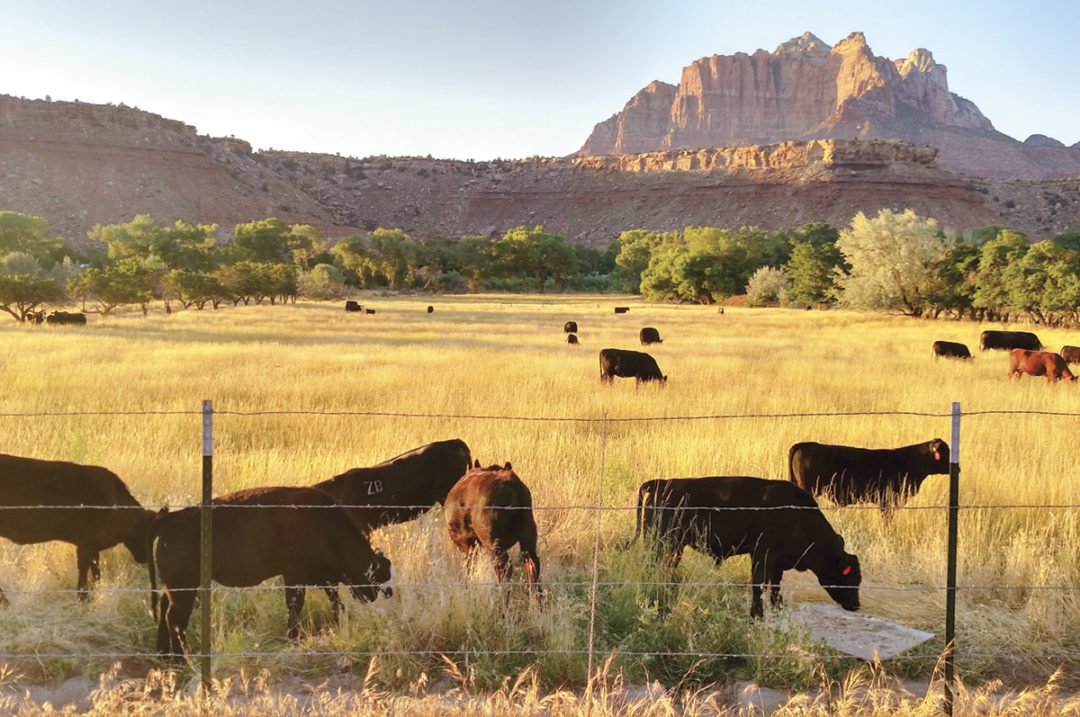The transition from summer to fall can bring tremendous uncertainty for beef cattle producers. The shorter day length not only signals the coming cooler weather, but also the end of the growing season for most forages, especially warm-season grasses. As the plants mature and form seed heads, lush leaf growth ceases and the nutritional quality (protein and energy) of the forage will decrease. The rate and degree of the forage maturation is affected by rainfall, with wetter conditions sustaining better forage quality for longer.
Drier or drought conditions may not only speed up the maturation of the forage, but if dry conditions persist for long periods, the quantity of forage will suffer as well. Forage quality will typically decline at a faster rate than the energy and protein requirements of the cow herd. In order to bridge the resulting widening nutritional gap, ranchers can supply late-season grazing with supplemental crude protein in order to maintain production goals.
Protein nutrition of the cow herd can be simply summarized as: “Take care of the rumen microbes, and the rumen microbes will take care of the cow.” Rumen microbes are the allies responsible for converting forages of minimal nutritional value into nutritious meat and milk for humans. These rumen microbes not only ferment forages to produce volatile fatty acids (VFAs) that serve as energy currency for the cow, but also reproduce and become part of the nutrients for the cow as a high-quality source of protein.
In many cases for cows grazing forages, and especially as forages mature in late summer and fall, crude protein (nitrogen) will be the most limiting nutrient for rumen microbial activity. When rumen microbes are restricted with regard to available nitrogen, the efficiency of rumen fermentation suffers and the rate of microbial reproduction slows, creating a need for supplemental protein. When this rumen nitrogen deficit is filled by feeding supplemental protein to the animal, multiple positive outcomes are achieved. Not only is the protein deficiency corrected directly, but when the rumen microbes have adequate protein, the fermentation activity increases so that additional energy is extracted from lower-quality forages, thus improving the protein and energy status of grazing animals late in the growing season.
Common signs of protein-deficient grazing animals are stacking manure piles, lost body condition and restless, hungry activity by cows despite abundant access to forage. Forage analysis can be conducted to provide definitive analysis of nutritional quality. Producers with an understanding and awareness of the forage quality and animal requirements can supplement accordingly to avoid lost productivity.
Supplemental protein is derived from three primary sources: plant, animal or non-protein nitrogen (NPN) sources such as biuret or urea. All sources have their pros and cons and may provide value in a supplemental protein program. Plant protein is the most common source of supplemental protein and can include high-quality forage like alfalfa, but more commonly are byproducts of plant or grain processing like soybean meal, cottonseed meal, distillers grains and wheat midds. Animal-derived proteins can be direct byproducts of animal processing like blood meal and feather meal that mostly bypass the rumen and complement the protein supplied by the rumen microbes. As previously mentioned, a naturally occurring source of animal protein is microbial protein, which is often called an ideal protein in terms of amino acid profile and can meet up to 100% of the protein needs of a cow. Non-protein nitrogen refers to components such as biuret and urea, which are not proteins but can be converted into proteins by rumen microbes. Due to their high crude protein content, they can be an economical source of nitrogen for rumen microbes when fed in the proper balance relative to other dietary nutrients and available energy. Biuret is a safe source of NPN that has an ammonia release curve in the rumen similar to soybean meal. Its elevated protein value allows for feeding at low levels in forage-based diets and is safer than feeding urea.
Protein supplementation strategies vary, and each producer must evaluate which method works best for their operation. A strategic protein supplementation program will evaluate factors including animal requirements, protein source, price, availability, handling, convenience and labor considerations. Protein supplementation programs can be divided into free-choice or hand-fed delivery programs for grazing cattle. Free-choice products can include blocks, tubs and loose meal products that provide a convenient delivery mechanism with generally minimal logistics, handling and labor.
Another positive of free-choice products is better grazing distribution that allows for better forage utilization in hard-to-reach parts of pastures. Hand feeding is the most common and precise delivery method and is often the lowest cost per ton of product, but may require significant investment in terms of logistics, equipment and time. Hand feeding can also be an effective animal husbandry mechanism to check and handle cattle in a low-stress manner. A nutritional consultant can help ranchers evaluate various supplementation strategies and formulations to complement their operational resources and improve profit potential.
Strategic protein supplementation is a cost-effective way to maximize the utilization of low-quality forages late in the grazing season. Additionally, late-season protein supplementation will increase cattle productivity relative to body condition and weight gain. Higher daily gains or weaning weights will not only increase the paycheck at selling time, but cows that are in better body condition going into winter will require less supplemental feed in the winter feeding program. Beef cattle producers can rely on their nutritionists to make choosing between protein supplements strategies an easy and efficient process. Look for and utilize science-backed, free-choice supplemental protein products that are formulated to provide the proper proportions and amounts of protein, minerals and vitamins that cattle need for improved health and well-being, breeding soundness, better weight gain and, ultimately, the greatest profitability.









